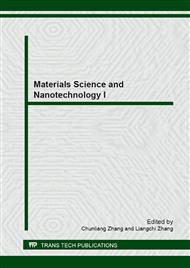[1]
Fox, M.A., Dulay, M.T., Heterogeneous photocatalysis, Chem. Rev. 93 (1993) 341-357.
Google Scholar
[2]
Chen, S.F., Cao, G.Y., Photocatalytic oxidation of nitrite by sunlight using TiO2 supported on hollow glass microbeads, Sol. Energy (2002) 7315-7321.
DOI: 10.1016/s0038-092x(02)00033-6
Google Scholar
[3]
Choi, W., Termin, A., Hoffmann, M.R., 1994. The role of metal ion dopants inquantum-sized TiO2:Correlation between photoreactivity and charge carrier recombination dynamics, J. Phys. Chem. 98 (1994) 13669-13679.
DOI: 10.1021/j100102a038
Google Scholar
[4]
Di Quarto, F., Di Paola, A., Sunseri, C., Semiconducting properties of anodic WO3 amorphous films, Electrochim. Acta 26, 1981. 1177-1184.
DOI: 10.1016/0013-4686(81)85095-5
Google Scholar
[5]
Santato,C.,Odziemkowski, M., Ulmann, M., Augustynski, J., Crystallographically oriented mesoporous WO3 films: Synthesis, characterization, and applications, J. Am. Chem. Soc. 123, (2001) 10639-10649.
DOI: 10.1021/ja011315x
Google Scholar
[6]
Wang, H.L., Lindgren, T., He, J.J., Hagfeldt, A., Lindquist, S., Photolelectrochemistry of nanostructured WO3 thin film electrodes for water oxidation: Mechanism of electron transport, J. Phys. Chem. B 104 (2000) 5686-5696.
DOI: 10.1021/jp0002751
Google Scholar
[7]
Liu,Y.,Xie,C.,Li, H.,Chen, H.,Zou, T.; Zeng, D., Improvement of gaseous pollutant photocatalysis with WO3/TiO2 heterojunctional-electrical layered system, J. Hazard. Mater. 196 (2012) 52-58.
DOI: 10.1016/j.jhazmat.2011.08.067
Google Scholar
[8]
Bi, D.; Xu, Y., Improved Photocatalytic Activity of WO3 through Clustered Fe2O3 for Organic Degradation in the Presence of H2O2, Langmuir 27 (2011) 9359-9366.
DOI: 10.1021/la2012793
Google Scholar
[9]
Qamar, M.,Yamani, Z. H.,Gondal, M. A.; Alhooshani, K., Synthesis and comparative photocatalytic activity of Pt/WO3 and Au/WO3 nanocomposites under sunlight-type excitation, Solid State Sci. 13 (2011) 1748-1754.
DOI: 10.1016/j.solidstatesciences.2011.07.002
Google Scholar
[10]
Liu, Y., Li, Y.,Li, W.,Han, S.; Liu, C., Photoelectrochemical properties and photocatalytic activity of nitrogen-doped nanoporous WO3 photoelectrodes under visible light, Appl. Surf. Sci. 258, (2012), 5038-5045.
DOI: 10.1016/j.apsusc.2012.01.080
Google Scholar
[11]
Takeuchi, M.,Shimizu, Y.,Yamagawa, H.,Nakamuro, T.; Anpo, M., Preparation of the visible light responsive N-doped WO3 photocatalyst by a thermal decomposition of ammonium paratungstate, Appl. Catal. B 110 (2011) 1-5.
DOI: 10.1016/j.apcatb.2011.08.004
Google Scholar
[12]
Radecka, M., Sobas, P., Wierzbicka, M., Rekas, M., Photoelectrochemical properties of undoped and Ti-doped WO3, Physica B 364 (2005) 85-92.
DOI: 10.1016/j.physb.2005.03.039
Google Scholar
[13]
Feng, C.,Wang, S.; Geng, B., Ti(IV) doped WO3 nanocuboids: fabrication and enhanced visible-light-driven photocatalytic performance, Nanoscale (2011) 3695-3699.
DOI: 10.1039/c1nr10460h
Google Scholar
[14]
Wang, F.,Di Valentin, C.; Pacchioni, G., Doping of WO3 for Photocatalytic Water Splitting: Hints from Density Functional Theory, J. Phys. Chem. C 116 (2012) 8901-8909.
DOI: 10.1021/jp300867j
Google Scholar
[15]
Cheng, X. F., Leng, W. H.,Liu, D. P.,Zhang, J. Q.; Cao, C. N., Enhanced photoelectrocatalytic performance of Zn-doped WO3 photocatalysts for nitrite ions degradation under visible light, Chemosphere, 68 (2007) 1976-1984.
DOI: 10.1016/j.chemosphere.2007.02.010
Google Scholar


